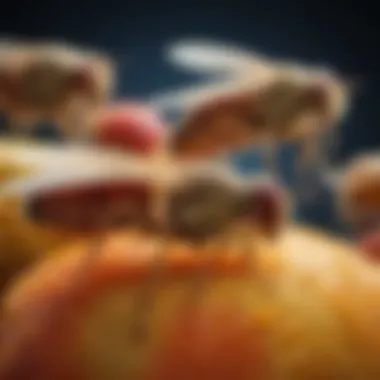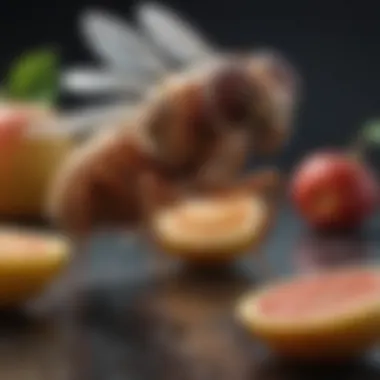Safe and Effective Ways to Get Rid of Fruit Flies


Intro
Fruit flies can be notoriously tricky little pests, often arriving uninvited and sticking around longer than expected. These tiny insects, known scientifically as Drosophila melanogaster, thrive in homes, particularly where there are ripe or rotting fruits. It's not just an inconvenience; they can quickly multiply, turning a minor annoyance into a full-blown infestation, much to the dismay of families.
Understanding how to effectively manage and eliminate fruit flies is crucial for any homeowner. This guide aims to arm you with practical and natural strategies that you can incorporate into your routine. By focusing on environmentally friendly solutions, you can ensure a clean and safe home environment while addressing the fruit fly dilemma effectively.
Pest Identification
To tackle any pest, one must begin by understanding it. Fruit flies, small but mighty, are usually no more than 1/8 inch long. They have a distinct tan or yellowish body, with red eyes that make them somewhat identifiable.
Detailed descriptions of common pests
While the fruit fly is primarily the focus, it’s worth noting similar household pests that can confuse homeowners:
- Vinegar flies: Often mistaken for fruit flies, they can create a similar level of annoyance, particularly in kitchens.
- Midges: These look similar but tend to swarm around moist areas rather than fruits.
Signs and symptoms of infestations
Recognizing the signs of a fruit fly infestation can save you a lot of time and headache:
- Visible flies: You might first notice them darting around your kitchen, especially near fruit bowls or garbage bins.
- Eggs and larvae: If you look closely, small white larvae or clusters of tiny eggs may be present on fermenting fruits or inside drains.
- Musty odor: A pungent smell often accompanies a large infestation, productive of rotting organic matter.
An early visual identification can cut down on extermination time and effort.
Prevention Strategies
Prevention is undeniably the best cure. When it comes to fruit flies, taking proactive steps can prevent the bugs from taking root in your abode.
Home maintenance tips for pest prevention
- Seal your fruits: Keeping fruits in the refrigerator can significantly stall the life cycle of fruit flies.
- Dispose of waste regularly: Make it a habit to empty your garbage bins frequently and ensure they’re sealed tightly.
- Clean up spills promptly: Any sugar-based spills should be cleaned right away to prevent attraction.
Natural deterrents and barriers
By using a few everyday items, you can create barriers that deter fruit flies:
- Herbs: Basil and mint can act as live deterrents when placed near fruit bowls — they dislike the smell.
- Vinegar traps: A simple bowl filled with apple cider vinegar covered with cling wrap, punctured with small holes can attract and trap these pesky pests.
Treatment Options
If prevention fails and the flies have taken hold, it’s time to consider treatment options. While chemical solutions exist, many prefer natural treatments that are less harmful to one's family and pets.
Overview of chemical vs. natural treatments
- Chemical options: These include traditional sprays and foggers; they're often effective but come with a risk to household safety.
- Natural remedies: Options such as essential oils, vinegar traps, or surgical cleaning of infested areas promote a healthier living environment.
Step-by-step guides for DIY treatments
Creating your own treatment is straightforward:
- Identify hotspots: Locate areas where flies congregate.
- Set up traps: Mix equal parts of water and apple cider vinegar in a small bowl, cover it with plastic wrap, and poke small holes in the top.
- Monitor regularly: Check your traps daily, disposing of captured flies as needed.
By following these steps, homeowners can regain control over their living spaces. Armed with knowledge and practical tools, dealing with fruit flies needn't be a daunting chore.
Understanding Fruit Flies
Fruit flies are often seen as merely pesky intruders in our kitchens, but understanding them goes a long way in managing their presence effectively. Recognizing the nature of these small insects can empower homeowners to take proactive measures rather than reactive ones. With their rapid life cycles and keen attraction to overripe fruits and sugary substances, it is crucial to comprehend essential aspects of their biology and behavior to tackle infestations with precision.
Life Cycle and Behavior
The life cycle of fruit flies unfolds in several distinct stages: eggs, larvae, and adults. Each stage plays a significant role in the persistence of these pests and understanding them can help us devise effective strategies for their elimination.
Eggs
Fruit fly eggs measure around 0.8 mm and are typically laid on the surface of fermenting fruits or vegetables—a key characteristic that speaks volumes about their lifestyle and habits. Astoundingly, females can lay hundreds of eggs at a time, this reproductive capacity highlights a significant challenge in managing their populations. Getting familiar with the fact that these eggs are nearly invisible to the naked eye is essential. This detail demonstrates that an infestation can begin without notice. Recognizing where these eggs are laid, typically in areas where ripe produce is kept, will help combat their growth at the root level, making this a beneficial focus point in our overall strategy.
Larvae
Once the eggs hatch, larvae emerge and begin feeding on the decaying organic matter around them. This stage is characterized by their small, white bodies that wiggle as they feed, often going unnoticed unless specifically looked for. The larvae stage is critical because this is when more damage is done—destroying your fruits, and further promoting the life cycle. This characteristic makes larvae an important aspect to consider when attempting to deceive fruit flies into traps or to evaluate the severity of an infestation. Knowing this can guide what preventative measures might be necessary to keep infestation at bay.
Adults
The adult fruit flies are the most recognizable stage. They typically appear small, around 1/8 inch long, and can be identified by their brownish or yellowish color with black markings. What’s fascinating about adult fruit flies is their ability to navigate quickly towards scent trails that signify ripe or fermenting food. This aspect not only highlights their behavior but also directs how we approach traps and solutions in this article. Understanding their adult behavior can be beneficial for implementing various strategies effectively, particularly concerning your household cleaning practices and storage techniques.
Common Signs of Infestation
Spotting signs of infestation early can make a world of difference when dealing with fruit flies. Knowing their common indicators aids in prompt identification and ultimately eradication of the problem.


Visible Flies
When you spot one or two fruit flies hovering around your kitchen, take it as a warning bell. Visible flies are perhaps the most obvious indicator of an infestation and signal that immediate action is required. They tend to congregate where food is present, buzzing around fruits or open liquids. Their presence is an immediate call to inspect your surroundings to determine the source and take action accordingly.
Decaying Produce
A tell-tale sign that invites fruit flies is decaying produce left on countertops or in fruit bowls. As fruits begin to spoil or rot, they release specific odors that attract these pests. Checking your produce regularly is a good practice. Finding shriveled or mushy fruits can signify that this organic matter could become a breeding ground. In recognizing this pattern, you can take preventive measures to avoid any increasing fly population.
Fermenting Liquids
Spilled juice, wine, or any fermenting liquid can be a magnet for fruit flies. The scent of fermentation is irresistible to adult flies, driving them to investigate. Even small amounts of liquid can attract them, so it’s vital to clean up spills immediately. When an open bottle of wine sits unattended, it becomes not just a drinking invitation but also a welcoming mat for these pests. Wiping surfaces promptly can help reduce their attraction to your home.
By gaining insights into the life cycle and behavior of fruit flies, alongside recognizing signs of infestation, you can form a strategic approach to managing these pests effectively. With careful observation and understanding, addressing and eliminating fruit flies becomes less stressful.
Identifying Attractants
Understanding what draws fruit flies into your home is crucial for effectively dealing with an infestation. By identifying these attractants, homeowners can put preventive measures in place to minimize future encounters with these tiny pests. The more awareness one has about what feeds their presence, the better equipped they are to create a fruit fly-free zone in their kitchens and living areas.
Common Sources of Attraction
Fruits and Vegetables
Fruits and vegetables are perhaps the biggest culprits behind the lure of fruit flies. It’s not just the food itself that attracts them, but the ripening process which produces natural sugars and odors. Overripe bananas or a neglected tomato on the countertop significantly increase the chances of an infestation taking root. The alluring sweetness of these foods makes them a prime target.
Moreover, the skin of fruits and veggies often houses microscopic imperfections that emit scents appealing to fruit flies. However, it’s a double-edged sword: while fresh produce is necessary for a healthy diet, it must be monitored closely. Keeping fruits and vegetables properly stored can limit their attraction to fruit flies.
Spilled Drinks
It’s easy to overlook that spillages of sweet beverages can create a breeding ground for fruit flies. A forgotten cup of soda or juice left unattended can send out invitations to these pests. The sticky residue and sugary scents from spilled drinks serve as a buffet for fruit flies. This reminds us why consistent cleaning is vital, particularly in areas where drinks are consumed. Neglecting spilled drinks might seem trivial, but it carries significant attractant potential.
Food Waste
Food waste holds a treasure trove of nutrients that fruit flies simply can’t resist. Leftover scraps in trash bins or compost bins can be a magnet for these pests, turning your waste disposal area into their breeding haven. They love to feast on decaying matter, and this is crucial for keeping kitchens clean and enticing for homeowners. With food waste being a common issue in busy households, it creates a domino effect in drawing fruit flies. Implementing a regular disposal routine is essential, as it reduces the chances of attracting these unwelcome guests.
Understanding Scent Attraction
Sweet Aromas
The delightful scent of ripe fruits can draw just about anyone’s attention, but it acts the same way for fruit flies. Sweet aromas act as signaling beacons, guiding these pests right to the source. This specific attraction is significant; it shows how nature has wired the flies to seek out the easiest food sources. Therefore, it’s beneficial to consider how scents can work both ways. While pleasant fragrances may attract pests, using strong-smelling herbs or spices in cooking can potentially deter fruit flies.
Fermentation Odors
Fermentation odors, often associated with decomposing fruit, can also be a major attractant. As certain foods begin to break down, they release specific scent combinations that can be irresistible to fruit flies. This aspect highlights the importance of monitoring both the foods we leave out and those that might be forgotten in the fridge. Fermentation is a natural process, but if neglected, it can swiftly lead to a fruit fly frenzy. So, keeping a keen eye on perishables can save trouble in the long run.
Preventive Measures
Taking preventive measures is essential to managing fruit fly infestations. These tiny pests can quickly turn a delightful fruit bowl into a troublesome breeding ground. By integrating practical steps into your daily routine, you can significantly reduce the chances of their unwelcome visit and keep your living space pest-free. Prevention not only minimizes the risks of an infestation but also simplifies your cleaning and elimination efforts later on.
Cleaning and Hygiene Practices
Washing Produce
Washing your fruits and vegetables can’t just be a casual afterthought; it’s a crucial element in controlling the fruit fly population. When you wash produce thoroughly, it physically removes the microscopic eggs and larvae that may have hitchhiked from the store. The characteristic of this simple action is that it is effective and doesn’t require elaborate setups or costly supplies.
One unique feature of washing produce is that it promotes a healthier lifestyle. Fresh fruits and veggies remain crisp and ready for consumption without worrying about potential contamination. Yet, it’s also worth noting that not all produce should be washed the same way. Delicate berries might need a gentler approach to avoid damage. If it’s not done right, it could lead to spoilage or even promote mold growth.
Regular Trash Disposal
Another cornerstone of maintaining a fruit fly-free environment involves managing your trash. Getting rid of food waste regularly includes emptying your bins on a consistent schedule and ensuring they are clean when you toss them. This effort can severely limit the quantity of decaying material available for fruit flies to sniff out.
The key characteristic of regular trash disposal is its simplicity—just make it a habit. It requires minimal time but yields excellent results. However, one should also be cautious; neglecting this practice can lead to odors that not only attract fruit flies but also contribute to other pest problems. If you miss a day or two, you might end up with more than just pesky flies buzzing around your kitchen.
Countertop Cleaning
Clean countertops serve as both a preventive measure and an immediate solution. Regularly wiping down surfaces not only removes crumbs and spills but also eliminates the microorganisms that might attract fruit flies in the first place. This practice emphasizes the importance of a tidy kitchen, as even small flecks of food can become a feast for these pests.
A unique benefit of countertop cleaning is that it instills discipline in your kitchen habits—clean spaces lead to clean cooking. Still, one challenge can be the use of the right cleaning supplies. Some people might opt for harsh chemicals, which can pose risks, particularly if children or pets are around. Choosing eco-friendly cleaning products can be both an effective and safer choice.
Proper Storage Techniques
Sealing Food
Effective food storage is critical in the quest against fruit flies. Sealing food in airtight containers prevents access to the enticing scents that can hook these pests. The importance of this practice lies not just in securing the food itself but in creating a barrier against potential infestations.
One remarkable feature of sealing food is its dual functionality of maintaining freshness. This technique not only keeps your produce longer but also internalizes odors that fruit flies find irresistible. However, a downside is that buying the right containers might require an initial investment. It’s a one-time cost with long-term benefits, making it a valuable method worth considering.
Using Refrigeration
Lastly, refrigeration significantly cuts down the fruit fly problem. When you place your ripe fruits or vegetables in the fridge, those appealing aromas—sweet and ripe—are kept under wraps, keeping flies at bay. The key aspect of this method is its effectiveness; it’s hard for any pest to infiltrate when food is stored in cold environments.


Using refrigeration has its unique perks, particularly extending the shelf life of perishable items. On the flip side, not all fruits do well under cold conditions. Some fruits, like bananas, may develop black spots when refrigerated, which calls for a little finesse in storage strategies. It’s a matter of weighing the benefits against the potential downsides for the betterment of your household.
Natural Solutions for Elimination
When it comes to handling fruit fly infestations, opting for natural solutions not only aligns with a desire for safety but also reflects a commitment to sustainable practices. These methods are often simple and accessible, relying on ingredients commonly found in households. Using natural approaches can also keep chemical exposure to a minimum, protecting both family health and the environment.
Natural methods take advantage of the inherent traits of fruit flies, such as their attraction to specific scents. Understanding this behavior allows homeowners to set effective traps and utilize strategies that can mitigate these pesky visitors without adverse effects.
Vinegar Traps
Creating a Simple Trap
Creating a simple vinegar trap is perhaps one of the most straightforward yet effective methods for dealing with fruit flies. The beauty of this solution lies in its accessibility; all it takes is a jar, some vinegar, and perhaps a funnel.
To make it, you can fill a jar with apple cider vinegar, which is a sweet-smelling lure for fruit flies, and cover it with plastic wrap secured by a rubber band. Poking small holes in the wrap allows the flies to enter but makes it difficult for them to escape. This method is not just easy; it leverages the flies’ innate attraction to scents, making it a beneficial approach for any homeowner facing an infestation.
Unique Features and Advantages
- Cost-effective: Most households already have vinegar on hand.
- Non-toxic: Unlike many commercial traps, this method doesn’t involve harmful chemicals.
However, it's also worth noting that while effective, vinegar traps require maintenance. You must regularly check to ensure that the jar doesn't overflow or lose its effectiveness.
Effectiveness of Different Vinegars
Not all vinegars are created equal when it comes to trapping fruit flies. Apple cider vinegar is renowned for its success, owing to its strong, sweet aroma. However, other types, such as white vinegar, can also be used—but with varied results. Using different vinegars may yield insights into what works best in a specific environment.
Key Characteristics
- Strong Attraction: Apple cider vinegar is particularly effective due to its scent profile.
- Comparative Study: Testing different types allows for tailored approaches based on specific preferences of flies in your area.
One disadvantage is that while the distinct aroma attracts fruit flies, it may also be less effective in homes with other competing odors.
Fruit Traps
Using Overripe Fruit
Another natural solution is using overripe fruit as a trap. This method employs the very instincts that lead to a fly's attraction to soft, decaying produce. Simply placing an overripe banana or other decayed fruit in a jar can lure fruit flies in.
Benefits of this Method
- Natural Appeal: Flies are instinctively drawn to the sugary, fermented scent of overripe fruit.
- Utilization of Waste: This tactic allows for the use of fruit that may have otherwise gone to waste, thus making it an eco-friendly choice.
However, it’s necessary to monitor this type of trap because as the fruit continues to decay, it may generate odors that could attract more fruit flies rather than deter them, potentially complicating the situation.
Limitations of This Method
While using overripe fruit can be effective, it comes with its own challenges. The key limitation is that it can also act as an attraction for more flies around the home, especially if not managed well.
Key Features and Disadvantages
- Short-lived: Overripe fruit must be replaced regularly to maintain effectiveness.
- Potential Draw: If the trap isn't monitored, it can exacerbate an already troublesome situation by attracting more flies.
By understanding these natural solutions, homeowners can tackle fruit fly problems in a way that is not just effective but also safe and sustainable.
Chemical Solutions: A Last Resort
In the quest to rid your home of fruit flies, resorting to chemical solutions should only be the last move on your chessboard. While natural methods are all well and good, sometimes those little pests just won't give up the ghost. Yet, it's crucial to understand that the chemicals you choose can have substantial consequences, not only for the insects but also for the environment and your household’s health. Therefore, analyzing the pros and cons is vital before taking a plunge into the chemical world.
Insecticidal Sprays
Ingredients to Avoid
When selecting an insecticidal spray, some ingredients should raise red flags. Notably, chemicals like chlorpyrifos and propoxur come with risks that can outweigh their benefits. These active substances have been linked to health hazards such as respiratory issues and neurological damage. Even the best of us can have some bad days, and exposure to such ingredients is no joke. A safer approach would be to opt for botanical insecticides, which can eliminate fruit flies without wreaking havoc on your air quality.
- Key Characteristics: Ingredients to avoid are predominantly synthetic, and their use can lead to environmental pollution.
- Why It’s Popular: Many people mistakenly believe that harsher chemicals guarantee effective results. However, they often come with health risks and can harm beneficial insects as well.
- Unique Features: These harmful ingredients are usually cheap and easy to find at local stores, leading homeowners to consider them a quick fix. The downside? A quick fix often results in a long-term headache.
Usage Instructions
Using insecticidal sprays effectively requires more than just spraying and saying a little prayer. There is a method to this madness. Understanding the timing and technique can impact the results significantly. For instance, applying the spray in the evening when flies are less active can enhance effectiveness while minimizing risk to others.
- Key Characteristics: Proper usage instructions stress correct dilution rates and application methods—important for maximizing insect control while keeping health risks low.
- Why It’s Beneficial: Following guidelines ensures that you are not wasting your product or putting your home in jeopardy.
- Unique Features: These instructions often include safety tips regarding protective gear, making them a critical read. Ignoring them could bring unwanted issues into your serene space.
Indoor Safety Guidelines
Ventilation
Good ventilation plays a pivotal role when dealing with chemicals. Opening windows and using fans can help disperse harmful particles, making the space safer for both human occupants and pets. This is especially crucial after applying any insecticidal spray because lingering fumes can create discomfort or health setbacks.
- Key Characteristics: A well-ventilated area promotes a faster breakdown of chemical particles, reducing potential toxicity.
- Why It’s a Smart Choice: Enhancing airflow can dramatically lessen health risks, providing peace of mind when using substances that could otherwise spell trouble.
- Unique Features: Opening windows not only helps clear out smells but can also create a less desirable environment for flies, as they love stagnant air.


Protecting Non-target Species
When applying chemical solutions, taking care to protect non-target species is not just a nice-to-have; it’s essential. Our homes can host various creatures, including beneficial insects, pets, and even plants that add charm to the space. Using sprays indiscriminately can lead to unwanted casualties in your home’s ecosystem.
- Key Characteristics: Protecting non-target species involves understanding how chemicals affect various organisms.
- Why It’s Important: The ecological repercussions are substantial. Killing bees and other pollinators as collateral damage can have far-reaching effects beyond just your fruit fly problem.
- Unique Features: Certain insecticides can be less harmful if applied selectively or when non-target species are less active, allowing for effective pest management that doesn’t disrupt the entire habitat.
"Effective pest control is not just about ridding your home of invaders; it’s also about preserving the delicate balance of your household ecosystem."
When to Seek Professional Help
Dealing with fruit flies can feel like a never-ending battle. When home remedies and preventive measures start to falter, it begs the question—when should you call in the experts? Understanding when to seek professional assistance is crucial not only for resolving an infestation but also for ensuring the safety and hygiene of your living space. Here’s what you should consider:
Identifying Persistent Infestations
Volume of Flies
The sheer volume of flies is a significant indicator. If you start noticing swarms buzzing around your kitchen or any other areas, it’s time to assess the situation. A handful of fruit flies is manageable, but when you find dozens—or worse, hundreds—infesting your space, it’s typically a sign of a more underlying issue.
This heavy presence reflects an established breeding ground nearby, likely from hidden spots like under appliances or inside cabinet cracks. Addressing such a large volume of flies without professional help is akin to bailing water out of a sinking ship without fixing the leak. The benefits of a keen observation of fly quantity include:
- Early detection—Spotting the problem before it escalates.
- Targeted solutions—Allowing for focused pest control strategies.
When flies begin to appear everywhere, ranging from your fruits to your pantry, it’s advisable to consider professional intervention, ensuring that you tackle the heart of the issue, not just the surface symptoms.
Visibility of Infestation Sites
Another major aspect is the visibility of infestation sites. If you can pinpoint areas where flies congregate—whether around a bowl of overripe bananas or a spillage near your sink—it’s critical to act quickly. Not only does this visibility indicate breeding grounds, but it also helps professionals understand how extensive the infestation really is.
Recognizing where to look can turn the tide on this pest issue. Established sites often include:
- Kitchen counters or surfaces.
- Trash cans without lids.
- Any form of decaying food items, like compost bins.
The benefits of identifying these areas include:
- Informed strategies—Enabling pest control services to address the correct zones immediately.
- Tailored treatments—Allowing technicians to deploy solutions that work best for the specific site context.
Choosing a Pest Control Service
Selecting the right pest control service is not just about picking a name out of a hat. You need to ensure they meet your specific needs and expectations.
Evaluating Expertise
When it comes to evaluating expertise, look beyond buzzwords and flashy ads. Start by checking reviews online and asking for recommendations from friends or neighbors. Expertise in pest control is vital because not all companies understand the unique behavior of fruit flies—this can make or break the effectiveness of their solution.
A reliable pest control service should show proven experience in dealing with fruit fly infestations.
Some aspects to consider:
- Certifications—Ensure they have the necessary licenses.
- Methods utilized—Understand if they focus on eco-friendly solutions, which aligns with your desire for safe household practices.
Finding a company with a deep understanding of local pest behavior can facilitate a smoother treatment process, saving you time and hassle.
Understanding Treatment Plans
Lastly, understanding treatment plans is essential before signing any contract. If the service provider cannot explain the methods they plan to use and how it fits your situation, it’s a red flag. A transparent pest control plan should include:
- Timeline—How long it will take to see results.
- Safety precautions—What measures they’ll take to ensure your family and pets are safe.
- Follow-up procedures—How they intend to monitor the area after treatment has been applied.
Being informed about these aspects not only eases your mind but also allows you to set realistic expectations. It’s worth taking the time to understand their approach, identifying if it’s effective for your specific needs as a homeowner.
In sum, when faced with a fruit fly infestation, do not hesitate to reach out for professional help if you find yourself overwhelmed by their numbers or the locations of their breeding hotspots. A comprehensive evaluation can pave the way for effective solutions, allowing you to regain control over your living space.
The End
In the battle against fruit flies, a comprehensive understanding of their behavior, attractants, and effective elimination strategies proves to be paramount. This article has illuminated the various facets of dealing with these persistent nuisances through preventive methods, natural solutions, and when necessary, chemical interventions.
The significance of concluding on this topic lies in recognizing that every household is unique. The strategies discussed are adaptable, allowing homeowners to tailor their approach based on individual circumstances. For instance, understanding the lifecycle of fruit flies helps in pinpointing the optimal timing for intervention, increasing the chances of success.
"Prevention is better than cure." This age-old adage rings especially true with fruit flies. Implementing diligent cleaning practices and effective storage techniques can save a lot of hassle down the line. Moreover, resorting to natural elimination methods aligns with a growing desire for less harmful household chemicals.
Reflecting on the content provided, readers are encouraged to take these insights seriously. The journey to a fly-free home begins with awareness and responsibility. Keeping an eye on potential attractants, maintaining cleanliness, and utilizing the suggested traps can significantly assist in managing these pests.
Summary of Key Points
To encapsulate the journey we've taken:
- Understanding the life cycle and habits of fruit flies provides a solid foundation for tackling infestations effectively.
- Identifying attractants such as overripe fruits, spilled liquids, and decaying matter allows homeowners to preemptively reduce breeding sites.
- Preventive measures like thorough cleaning routines and proper food storage are crucial in diminishing fruit fly presence.
- Natural solutions like vinegar traps and fruit traps offer safe and effective means to manage fruit flies without resorting to harsh chemicals.
- Chemical solutions should be viewed as a last resort, used in conjunction with safety guidelines to protect non-target species and maintain indoor air quality.
- Professional help becomes necessary when infestations persist despite efforts, emphasizing the importance of choosing a competent pest control service.
Final Recommendations
Here are some final thoughts on eliminating fruit flies effectively:
- Stay proactive by regularly monitoring your kitchen and pantry for signs of infestations.
- Invest in proper storage solutions to keep fruits and vegetables sealed and stored in the refrigerator when possible.
- Take immediate action at the first sight of these flies, employing natural traps as your first line of defense.
- Educate your household members so everyone is on the same page regarding cleanliness and food disposal.
- If the problem escalates, research pest control services with strong track records and transparent treatment plans.
In essence, a coordinated, informed approach leads to effective fruit fly management, ensuring a pleasant living environment free from these pesky invaders.



